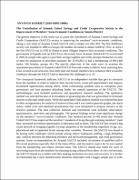| dc.description.abstract | ANYANGO HARRIET (2010-M093-10006)
The Contribution of Asamuk United Savings and Credit Co-operative Society to the Improvement of Members’ Socio-Economic Conditions in Amuria District.
The general objective of this study was to assess the contribution of Asamuk United Savings and Credit Cooperatives (SACCO) society in improving the members‟ socio-economic conditions, taking a case study of Asamuk United SACCO with a sample size of(n=40). The first Raiffeisen society was founded in 1886 in Europe, the number increased to almost 8,000 by 1912. In Africa the first SACCO was in 1959 in Ghana to assist villagers improve their economic conditions. The government of Uganda took up SACCOs at sub-county level. Asamuk United SACCO was formed in 2005 by people who agree to pool their savings together and credit amongst themselves in time of need for productive or provident purposes. By 31/03/2013 it had a membership of 690 (446 males, 180 females, groups 44.) The specific objectives of the study were: to examine the operational procedures of Asamuk United SACCO from sub-county to district level, assessing how it has created social networks, how both male and female members have enhanced their economic conditions through the SACCO and to determine the challenges in it. 43
The conceptual framework indicates SACCO as an independent variable that gets its resources from the members in order to improve their income levels, create job opportunities and improve investment opportunities among others. Some constraining variables such as corruption, poor governance and loan payment defaulting hinder the smooth operations of the SACCO. The methodologies used included qualitative and quantitative research methods. The qualitative method was selected because of its broadness in generating data that was generalised to formulate answers to the topic under study. While the quantitative data analysis method was selected because it offers an opportunity for analysis of numerical data and it was used to generate graphs, pie charts radars, radial cycle and tabulated presentations that were interpreted to propose answers to the research question. The data collection methods and instruments used included; observation, questionnaires, interviews and photography. The general findings reveal some significant change on the members‟ socio-economic conditions. One hundred percent (n=40) stated that Asamuk United SACCO has improved the members‟ standards of living through widening members‟ trade base, increased investment opportunities in education and in assets. The SACCO has created a big social network by bringing together varying categories of the membership regardless of age, sex, educational and occupational levels among other variables. However, the SACCO was found to be having some challenges which include among others: inadequate staffing, a high defaulting rate, conflicts between the defaulting members and the board/management, and weak governance systems. Some recommendations for Asamuk SACCO included; recruitment of qualified staff to fill vacant positions especially that of the loans officer, and the need to source for its own capital from the membership and reduce external loans. The SACCO should also lobby for ways of recovering loans from the members by obtaining strong collateral from them. As for civil servants, the SACCO should try to lobby with their banking institutions for easy loan recovery. It is further recommended that a more detailed study should be undertaken with a bigger sample size in order
to obtain more efficiency and effectiveness of the SACCOs, since the study was conducted with a sample of only 40 respondents (n-40).
Key Words: Savings, Credit Co-operative Society, Socio-Economic Conditions, Amuria District | en_US |


